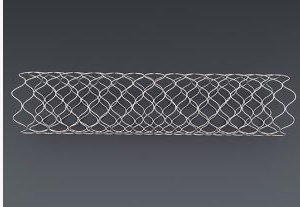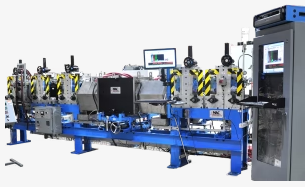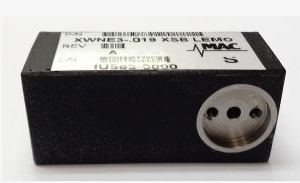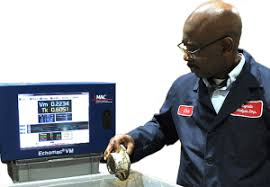These types of tubes are commonly found in heat exchangers used in oil refineries and for other large chemical processes, power generation and many other high liability, high down time cost applications. Many of these situations are also high pressure applications. Ultrasonic technology provides high quality detection of defects.
Heat exchanger tubes made of carbon steel, stainless steel, titanium alloys, copper and copper alloys and other metals require non-destructive testing (NDT) solutions that can meet ASTM E213, E570, E426 and EN 10893-10 inspection standards, as well as other standards.

Echomac® UT system inspecting stainless steel and titanium heat exchanger tube. Includes MAC inlet and outlet conveyor system.
- In heat exchangers tubes are subjected to mechanical stresses due to thermal driven linear contraction and expansion of the tube length and due to radial thermal gradients in the tubes.
- Heat exchanger tubes are also susceptible to any stress from the high pressures of the fluids themselves.
- Trained and experienced MAC® technicians can help you to determine which test method should be used, based upon each method’s inherent capabilities and limitations, as well as your unique requirements.
MAC® Solutions:
- Multimac® is MAC’s eddy current system. Many heat exchanger tubes are tested with encircling coil eddy current method only.
- Echomac® Ultrasonic Rotary Systems can cover a large OD range of longitudinally welded or seamless precision-drawn tubes. These machines are capable of testing tubes at the high test level mandated by the application and also the throughput rate required to match some large quantity heat exchanger tube orders.
- At high throughput rates, untested ends can be limited to 25mm to 50mm depending upon diameters and conditions.
- Our systems feature Echomac® FD-6 electronics with up to 32 channels and full network support for remote viewing and control.
MULTIMAC®
Eddy Current Instrument for Testing Tube, Bar, & Wire

- Operates with encircling, sector, or rotary test sensors.
- Up to eight test channels, null or absolute, can be used in any combination.
- Detect short surface and some subsurface defects in tube, bar, and wire.
- Inspect welded tube for short ID or OD defects in the weld zone.
ECHOMAC® FD6
For Flaw Detection, Thickness & Dimensional Measurement in Tube & Bar

- Versatile Ultrasonic tester with superior performance and versatile, intuitive operation.
- For full inspection of tubes, pipes and bars, plate and weld.
- Operate on or off line
- Upgrade and/or replace older ultrasonic testers
- Use with rotary, spin-the-tube, squirter and bubbler installations.
EDDY CURRENT TECHNOLOGY IN NDT
MAC’s® Eddy Current Testing (ECT) systems incorporate computer-based test instruments and test coils that use two ECT coil technologies: encircling and sector coils, and spinning or rotary probe coils.

- Encircling and sector Eddy Current coil tests perform in this manner
- The product is passed through or adjacent to an electrical test coil, which
has been excited by an alternating current. - This induces a flow of eddy currents around the test material or in the
case of a sector coil, in the area under the coil. - Short, intermittent anomalies or flaws cause a variation in the eddy
current pattern, which the instrument detects.
ULTRASONIC TECHNOLOGY IN NDT
High-speed Ultrasonic (UT) Systems enable a full volumetric examination of materials and are designed to detect surface, subsurface, internal and dimensional flaws.
This type of testing utilizes high-frequency sound waves that are transmitted throughout the material being tested in order to conduct a thorough inspection.

Echomac® 50mm Rotary Ultrasonic System with MAC conveyors testing stainless steel tube
- Ultrasonic inspection can be used to detect surface flaws, such as cracks, seams, and internal flaws such as voids or inclusions of foreign material. It’s also used to measure wall thickness in tubes and diameters of bars.
- An ultrasonic wave is a mechanical vibration or pressure wave similar to audible sound, but with a much higher vibration frequency. For NDT purposes, the range is usually from 1MHz to 30MHz or higher.
- Depending on the test requirements, these waves can be highly directional and focused on a small spot or thin line, or limited to a very short duration.
- Two methods of UT are used for flaw detection – Shear and Compression Wave.



